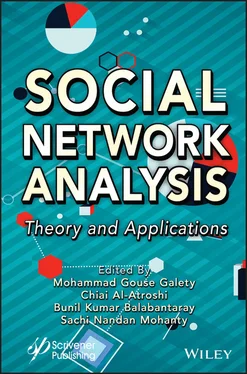Social Network Analysis
Здесь есть возможность читать онлайн «Social Network Analysis» — ознакомительный отрывок электронной книги совершенно бесплатно, а после прочтения отрывка купить полную версию. В некоторых случаях можно слушать аудио, скачать через торрент в формате fb2 и присутствует краткое содержание. Жанр: unrecognised, на английском языке. Описание произведения, (предисловие) а так же отзывы посетителей доступны на портале библиотеки ЛибКат.
- Название:Social Network Analysis
- Автор:
- Жанр:
- Год:неизвестен
- ISBN:нет данных
- Рейтинг книги:4 / 5. Голосов: 1
-
Избранное:Добавить в избранное
- Отзывы:
-
Ваша оценка:
- 80
- 1
- 2
- 3
- 4
- 5
Social Network Analysis: краткое содержание, описание и аннотация
Предлагаем к чтению аннотацию, описание, краткое содержание или предисловие (зависит от того, что написал сам автор книги «Social Network Analysis»). Если вы не нашли необходимую информацию о книге — напишите в комментариях, мы постараемся отыскать её.
As social media dominates our lives in increasing intensity, the need for developers to understand the theory and applications is ongoing as well. This book serves that purpose.
Audience
Social Network Analysis — читать онлайн ознакомительный отрывок
Ниже представлен текст книги, разбитый по страницам. Система сохранения места последней прочитанной страницы, позволяет с удобством читать онлайн бесплатно книгу «Social Network Analysis», без необходимости каждый раз заново искать на чём Вы остановились. Поставьте закладку, и сможете в любой момент перейти на страницу, на которой закончили чтение.
Интервал:
Закладка:
Table of Contents
1 Cover
2 Title Page
3 Copyright
4 Preface
5 1 Overview of Social Network Analysis and Different Graph File Formats 1.1 Introduction—Social Network Analysis 1.2 Important Tools for the Collection and Analysis of Online Network Data 1.3 More on the Python Libraries and Associated Packages 1.4 Execution of SNA in Terms of Real-Time Application: Implementation in Python 1.5 Clarity Toward the Indices Employed in the Social Network Analysis 1.6 Conclusion References
6 2 Introduction To Python for Social Network Analysis 2.1 Introduction 2.2 SNA and Graph Representation 2.3 Tools To Analyze Network 2.4 Importance of Analysis 2.5 Scope of Python in SNA 2.6 Installation 2.7 Use Case 2.8 Real-Time Product From SNA References
7 3 Handling Real-World Network Data Sets 3.1 Introduction 3.2 Aspects of the Network 3.3 Graph 3.4 Scale-Free Network 3.5 Network Data Sets 3.6 Conclusion References
8 4 Cascading Behavior in Networks 4.1 Introduction 4.2 User Behavior 4.3 Cascaded Behavior References
9 5 Social Network Structure and Data Analysis in Healthcare 5.1 Introduction 5.2 Prognostic Analytics—Healthcare 5.3 Role of Social Media for Healthcare Applications 5.4 Social Media in Advanced Healthcare Support 5.5 Social Media Analytics 5.6 Conventional Strategies in Data Mining Techniques 5.7 Research Gaps in the Current Scenario 5.8 Conclusion and Challenges References
10 6 Pragmatic Analysis of Social Web Components on Semantic Web Mining 6.1 Introduction 6.2 Background 6.3 Proposed Model 6.4 Building Social Ontology Under the Agriculture Domain 6.5 Validation 6.6 Discussion 6.7 Conclusion and Future Work References
11 7 Classification of Normal and Anomalous Activities in a Network by Cascading C4.5 Decision Tree and K-Means Clustering Algorithms 7.1 Introduction 7.2 Literature Survey 7.3 Methodology 7.4 Implementation 7.5 Results and Discussion 7.6 Conclusion References
12 8 Machine Learning Approach To Forecast the Word in Social Media 8.1 Introduction 8.2 Related Works 8.3 Methodology 8.4 Results and Discussion 8.5 Conclusion References
13 9 Sentiment Analysis-Based Extraction of Real-Time Social Media Information From Twitter Using Natural Language Processing 9.1 Introduction 9.2 Literature Survey 9.3 Implementation and Results 9.4 Conclusion 9.5 Future Scope References
14 10 Cascading Behavior: Concept and Models 10.1 Introduction 10.2 Cascade Networks 10.3 Importance of Cascades 10.4 Purposes for Studying Cascades 10.5 Collective Action 10.6 Cascade Capacity 10.7 Models of Network Cascades 10.8 Centrality 10.9 Cascading Failures 10.10 Cascading Behavior Example Using Python 10.11 Conclusion References
15 11 Exploring Social Networking Data Sets 11.1 Introduction 11.2 Establishing a Social Network 11.3 Connectivity of Users in Social Networks 11.4 Centrality Measures in Social Networks 11.5 Case Study of Facebook 11.6 Conclusion References
16 Index
17 Wiley End User License Agreement
List of Tables
1 Chapter 6Table 6.1 Questionnaires and responses of participants.
2 Chapter 7Table 7.1 Performance evaluation for the KDD99 data set without using the Featur...
3 Chapter 8Table 8.1 Twitter data set.Table 8.2 User data set is inactive.Table 8.3 Forecasting the word “happy” in inactive users.Table 8.4 Term data set active social media users.Table 8.5 Data set of active user.Table 8.6 Error and MAPE.
4 Chapter 9Table 9.1 The characteristics of social media platforms.Table 9.2 Literature survey summary.
List of Illustrations
1 Chapter 1 Figure 1.1 Social network analysis. Figure 1.2 Social network analysis using Python. Figure 1.3 Flowchart of social network.
2 Chapter 2 Figure 2.1 Comparison directed and undirected graph. Figure 2.2 Simple graph. Figure 2.3 Multigraph. Figure 2.4 Weighted graph. Figure 2.5 Unweighted graph. Figure 2.6 NodeXL network overview discovery and exploration in excel [5]. Figure 2.7 Python official documentation. Figure 2.8 Anaconda navigator. Figure 2.9 Conda environment installation. Figure 2.10 QR code for workbooks and source codes. Figure 2.11 Code blocks for importing libraries. Figure 2.12 Code block for reading data. Figure 2.13 Code block for reading edge list. Figure 2.14 Visualization of Facebook users. Figure 2.15 Code block for centrality measures. Figure 2.16 Visualization of centrality measures on Facebook users. Figure 2.17 Visualization of graph database used in business.
3 Chapter 3 Figure 3.1 The presentation of a small-scale network based on the interpersonal ... Figure 3.2 E-mail exchanges between company employees [2]. Figure 3.3 Links between web blogs as a form of a large network [2]. Figure 3.4 (a) Directed graph with 4 nodes [4]. (b) A graph with 4 nodes [4].Figure 3.5 Social networks quickly expand to reach many people [6].Figure 3.6 A small network that has one highly connected node, or hub [7].Figure 3.7 Scale-free network in vast size where the hub nodes could be distingu...
4 Chapter 4Figure 4.1 Aspects of cascading behavioral pattern.Figure 4.2 Cascading behavior in OSN.
5 Chapter 5Figure 5.1 Social network showing links and nodes in healthcare.Figure 5.2 Diagrammatic representation of existing methods.Figure 5.3 Diagrammatic representation of graph theory.
6 Chapter 6Figure 6.1 Building social semantic ontology for specific domain.Figure 6.2 Code for building agriculture ontology.Figure 6.3 Code for building object property.Figure 6.4 Usage of class crop in agriculture ontology.Figure 6.5 Code for defining restrictions in object property.Figure 6.6 Ontology graph for agriculture ontology.Figure 6.7 Code for social ontology.Figure 6.8 Asserted model for social ontology under agriculture domain.Figure 6.9 Analyzing social elements over agriculture domain ontology.Figure 6.10 Class hierarchy of social semantic ontology under agriculture domain...Figure 6.11 Code for object property in social ontology.Figure 6.12 Ontology graph for social semantic ontology.Figure 6.13 Validation of social semantic ontology.
7 Chapter 7Figure 7.1 Two viewpoints on the development of weblog information cascades. (a)...Figure 7.2 The development and topology of cascade networks.Figure 7.3 Links to cascades, left: perspective on relationships, right: perspec...Figure 7.4 A sample decision tree for use in computer network.Figure 7.5 (a) Outlier detection classification K = 2, (b) and (c) combined clas...Figure 7.6 Performance measurement index in graphical representation.
8 Chapter 8Figure 8.1 Overall methodology.Figure 8.2 Forecasting happy word.Figure 8.3 Forecasting “love” word.
9 Chapter 9Figure 9.1 Statista presented a ranking of social networks based on the number o...Figure 9.2 The semantic analysis framework in social media that transforms data ...Figure 9.3 Workflow of proposed system model.Figure 9.4 The user-side program’s activity diagram.Figure 9.5 Confusion matrix with 92.50% accuracy.Figure 9.6 Hashtag/keyword entry page.Figure 9.7 An examination of the effectiveness of positive and negative tweets.
10 Chapter 10Figure 10.1 Concept of graph theory.Figure 10.2 Connections in a graph.Figure 10.3 Linear threshold model. Source: https://snap-stanford.github.io/cs22...Figure 10.4 Independent cascade model.Figure 10.5 SIR model in python.Figure 10.6 SIR model graph showing susceptible, infected & recovered individual...Figure 10.7 Cascading behavior.Figure 10.8 Payoff matrix in coordination game.Figure 10.9 Payoff in cascading behavior.Figure 10.10 Keypeople in cascading behavior.Figure 10.11 Impact of communities on cascades.Figure 10.12 Cascading on clusters.
11 Chapter 11Figure 11.1 Nodes and edges in the graph.Figure 11.2 Nodes and edges in the social network.Figure 11.3 Python program for creating a symmetric social network using Network.
Читать дальшеИнтервал:
Закладка:
Похожие книги на «Social Network Analysis»
Представляем Вашему вниманию похожие книги на «Social Network Analysis» списком для выбора. Мы отобрали схожую по названию и смыслу литературу в надежде предоставить читателям больше вариантов отыскать новые, интересные, ещё непрочитанные произведения.
Обсуждение, отзывы о книге «Social Network Analysis» и просто собственные мнения читателей. Оставьте ваши комментарии, напишите, что Вы думаете о произведении, его смысле или главных героях. Укажите что конкретно понравилось, а что нет, и почему Вы так считаете.












